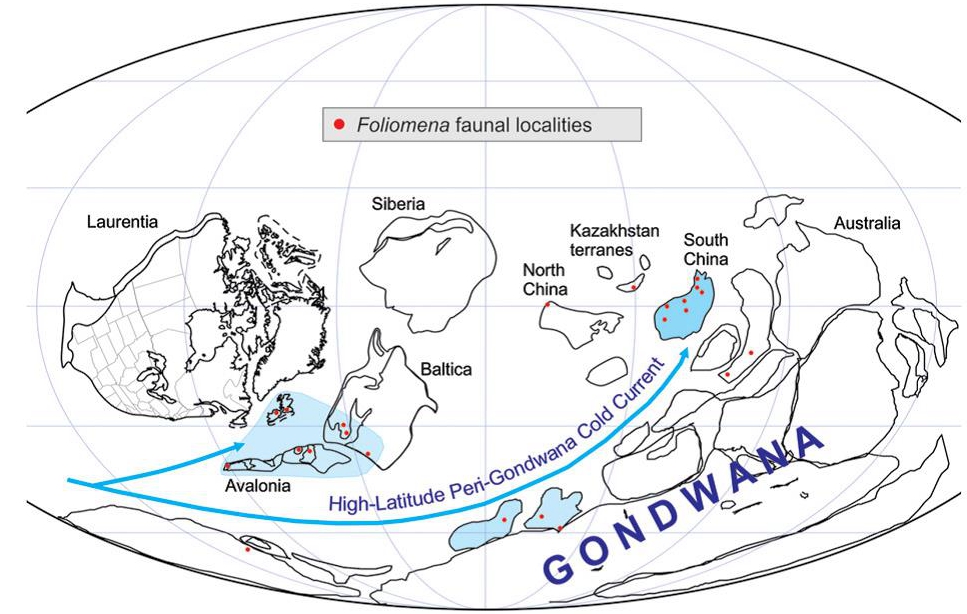
Late Ordovocian paleogeography, showing similarity between equatorial position of South China plate to that of modern Galápagos Islands.
The eastern equatorial Pacific cold tongue plays a vital influence on ocean-atmasphere CO2 exchange global climate patterns. Recently, a team from Nanjing Institute of Geology and Palaeontology, Chinese Academy of Sciences and Western University, Canada reported an equatorial cold-water tongue in the Late Ordovician on the basis of the evidence from paleontological, sedimentological and geochemical data. This research will be published on Geology lately.
Recent paleogeographic reconstructions place the South China plate in paleoequatorial latitudes during the Late Ordovician. The northward drift of South China has been extrapolated based on paleomagnetic data, which point to a southern subtropical position in the Early Ordovician and equatorial latitudes by the mid-Silurian. This paleogeographic reconstruction, however, apparently contradicts sedimentary, faunal, and newly acquired δ18Oconodont-apatite data, which show an overall change from Early Ordovician warm water to Late Ordovician cool-water depositional environments.
During the Early Ordovician, the carbonate facies of the Yangtze Platform have shallow and warm water characteristics, such as oolites of the Nantsinkuan and Fenghsiang Formations and Calathihum calcareous sponge reefs of the Hunghuayuan Formation. The brachiopod fauna is also characterized by the water-water taxa, such as Sinorthis, Finkelburgia and Tritoechia during the Early and early Middle Ordovician. In contrast, the Upper Ordovician sedimentary facies sedimentary facies and the benthic shelly faunas on the Yangtze Platform have characteristics of a cool-water origin. In the Upper Ordovician, the cool and deep-water Foliomena brachiopod fauna prevailed on the Yangtze Platform. Furthermore, a new stable-oxygen-isotopic curve, based on conodont apatite from the Ordovician succession of Yangtze Platform, shows an overall cooling trend through the Ordovician, implying a broad transition from a warm-water to a cool-water tropical environment, in contrast to the northward drift of South China from subtropical to equatorial latitude from Early to Late Ordovician.
In the Ordovician, the long coastline of Gondwana had a geographic setting similar to that of modern Antarctica-South America. The vast Gondwana land mass was centered on the South Pole. With continued global cooling during the Late Ordovician and onset of the continental ice cap, the cold water along high-latitude Gondwana likely generated deep or intermediate flows, as well as surface cold currents similar to the modern Humboldt Current, bringing nutrient-laden cool waters to the shallow ocean surface to form the Cold Tongue. In addition, South China during the Late Ordovician was similar to the Galápagos Islands today in their position within an equatorial cold tongue. This paleogeographic setting would have promoted cool-water upwelling to promote high primary productivity, episodic eutrophication, and organic-rich deposits.
This research was supported by the National Natural Science Foundation of China, the Strategic Priority Research Program of the Chinese Academy of Sciences, the Natural Science and Engineering Research Council of Canada.
Download:
